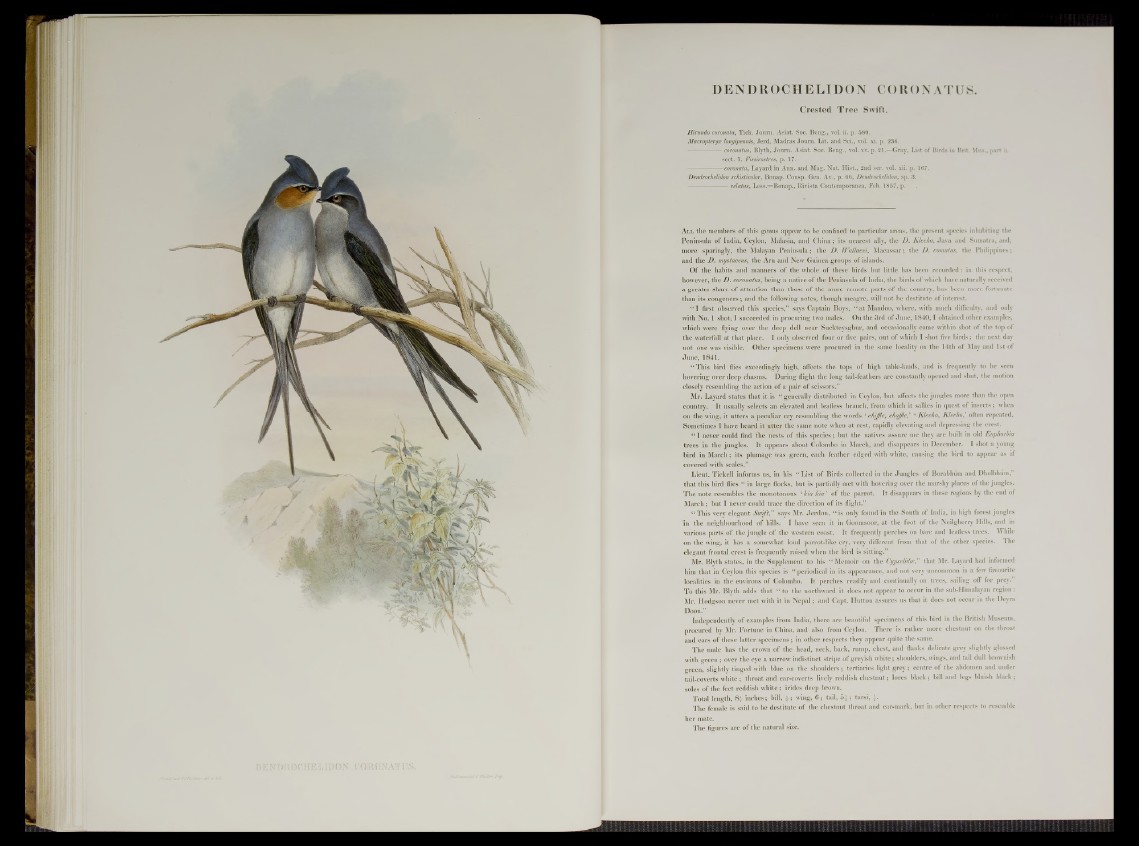
DENDROCHELIDON CORONATUS.
Crested T re e Swift.
Hirundo coronata, Tick. Journ. Asiat. Soc. Beng., vol. ii. p. 580.
Macropteryx longipennis, Jerd. Madras Journ. Lit. and Sci., vol. xi. p. 236.
coronatus, Blyth, Journ. Asiat. Soc. Beng., vol. xv. p. 21.—Gray, l i s t of Birds in Brit. Mas., part i
sect. 1. Fissirostres, p. 17.
coronata, Layard in Ann. and Mag. Nat. Hist., 2nd ser. vol. xii. p. 167.
• Dendroclielidon schisticolor, Bonap. Consp. Gen. Av., p. 66, Dendrochelidon, sp. 3.
velatus, Less.—Bonap., Rivista Contemporanea, Feb. 1857, p.
A ll the members of this genus appear to be confined to particular areas, the present species inhabiting the
Peninsula of India, Ceylon, Malasia, and China; its nearest ally, the D. Klecho, Java and Sumatra, and,
more sparingly, the Malayan Peninsula; the D. IVallacei, Macassar; the D. comat us, the Philippines;
and the D. mystaceus, the Aru and New Guinea groups of islands.
Of the habits and manners of the whole of these birds but little has been recorded: in this respect,
however, the D. coronatus, being a native of the Peninsula of India, the birds of which have naturally received
a greater share of attention than those of the more remote parts of the country, has been more fortunate
than its congeners; and the following notes, though meagre, will not be destitute of interest.
“ I first observed this species,” says Captain Boys, “ at Mandoo, where, with much difficulty, and only
with No. 1 shot, I succeeded in procuring two males. On the 3rd of June, 1840,1 obtained other examples,
which were flying over the deep dell near Suckteysghur, and occasionally came within shot of the top of
the waterfall at that place. I only observed four or five pairs, out of which I shot five birds; the next day
not one was visible. Other specimens were procured in the same locality on the 14th of May and 1st of
June, 1841.
“ This bird flies exceedingly high, affects the tops of high table-lands, and is frequently to be seen
hovering over deep chasms. During flight the long tail-feathers are constantly opened and shut, the motion
closely resembling the action of a pair of scissors.”
Mr. Layard states that it is “ generally distributed in Ceylon, but affects the jungles more than the open
country. It usually selects an elevated and leafless branch, from which it sallies in quest of insects; when
on the wing, it utters a peculiar cry resembling the words ■ chiffle, chaffle,’ ‘ Klecho, Klecho,’ often repeated.
Sometimes I have heard it utter the same note when at rest, rapidly elevating and depressing the crest.
“ I never could find the nests of this species; but the natives assure me they are built in old Euphorbia
trees in the jungles. It appears about Colombo in March, and disappears in December. I shot a young
bird in March; its plumage was green, each feather edged with white, causing the bird to appear as if
covered with scales.”
Lieut. Tickell informs us, in his “ List of Birds collected in the Jungles of Borabhum and Dholbhum,”
that this bird flies “ in large flocks, but is partially met with hovering over the marshy places of the jungles.
The note resembles the monotonous * kia kia ’ of the parrot. It disappears in these regions by the end of
M arch ; but I never could trace the direction of its flight.”
“ This very elegant Swift,” says Mr. Jerdon, “ is only found in the South of India, in high forest jungles
in the neighbourhood of hills. I have seen it in Goomsoor, at the foot of the Neilgherry Hills, and in
various parts of the jungle of the western coast. It frequently perches on bare and leafless trees. While
on the wing, it has a somewhat loud parrot-like cry, very different from that of the other species. The
elegant frontal crest is frequently raised when the bird is sitting.”
Mr. Blyth states, in the Supplement to his “ Memoir on the Cypselidte,” that Mr. Layard had informed
him that in Ceylon this species is “ periodical in its appearance, and not very uncommon in a few favourite
localities in the environs of Colombo. It perches readily and continually on trees, sailing off for prey.”
To this Mr. Blyth adds that “ to the northward it does not appear to occur in the sub-Himalayan region:
Mr. Hodgson never met with it in Nepal; and Capt. Hutton assures us that it does not occur in the Deyra
Doon.”
Independently of examples from India, there are beautiful specimens of this bird in the British Museum,
procured by Mr. Fortune in China, and also from Ceylon. There is rather more chestnut on the throat
and ears of these latter specimens; in other respects they appear quite the same.
The male has the crown of the head, neck, back, rump, chest, and flanks delicate grey slightly glossed
with green ; over the eye a narrow indistinct stripe of greyish white; shoulders, wings, and tail dull brownish
green, slightly tinged with blue on the shoulders; tertiaries light grey; centre of the abdomen and under
tail-coverts white; throat and ear-coverts lively reddish chestnut; lores black; bill and legs bluish black;
soles of the feet reddish white; irides deep brown.
Total length, 84 inches; bill, 4; wing, 6; tail, 5 | ; tarsi, 4.
The female is said to be destitute of the chestnut throat and ear-mark, but in other respects to resemble
her mate.
The figures are of the natural size.